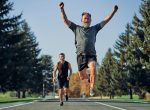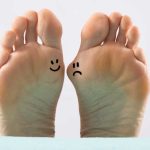What is Scoliosis?
Scoliosis is a sideways curvature of the spine. When looking at the spine directly from the back, it should appear as a straight line. With scoliosis, the spine appears to curve to one side, or both. The curving can involve twisting of the vertebrae which may be less perceptible to a nurse or a physician during a medical exam.
A small percent of children are born with scoliosis (called congenital scoliosis), but a majority of scoliosis cases develop in children during their adolescent and teen years, particularly during their growth spurt (generally between the ages of 10 and 15).
OrthoConnecticut has several orthopedic specialists who specialize in the treatment of congenital and idiopathic scoliosis.
What Causes Adolescent Idiopathic Scoliosis in Children?
In about 80% of cases, there is no known cause for scoliosis. This is called idiopathic scoliosis. Most cases of scoliosis in adolescents and teens fall into this category, which is why it is often referred to as Adolescent Idiopathic Scoliosis.
Childhood Scoliosis Risk Factors
Scoliosis is fairly common. Approximately 5-10 percent of the population has scoliosis. The total number of scoliosis cases in the United States is estimated to be greater than 4 million (National Scoliosis Foundation) and it is the most common spinal deformity in school-age children.
Heredity is a risk factor for developing scoliosis. Among patients with relatives that have scoliosis, about 20 percent develop the condition. In addition, less common causes of scoliosis include certain neuromuscular conditions, such as cerebral palsy or muscular dystrophy, as well as birth defects affecting spinal development and spinal cord abnormalities. Spinal injuries or infections may also cause scoliosis in a few cases.
While both boys and girls are equally at risk for scoliosis, girls are at a significantly higher risk of developing significant curving (more severe scoliosis) as they grow.
Signs of Scoliosis in Children
Signs of scoliosis can include:
- Uneven shoulders
- One shoulder blade that appears more prominent than the other
- Uneven waist
- One hip displaying higher than the other
- One side of the rib cage jutting forward
- One side of the back appearing more prominent when bending forward
Often, parents do not notice these signs. Mild curving can start without any symptoms and your child will likely not even be aware of it. The curving appears gradually, and does not cause pain. Pediatric physicians and internists look for curvatures during routine physical exams, and are often the first to notice any anomalies in spine shape. They will often refer people to spine specialists should any symptoms appear out of the ordinary.
Treating Scoliosis in Children and Teens
Scoliosis is most often detected during adolescence when children begin their growth spurts. Typically in girls this is around age 10-11, while in boys it is closer to age 11 or 12.
The good news is that most cases of mild scoliosis do not need treatment. When a child is recommended to OrthoConnecticut due to indications of scoliosis, the physicians generally take X-rays, and in some cases, MRIs, to determine the degree of curvature. Most children are then monitored on a regular basis to determine if the curvature continues to increase. Mild curvature generally requires annual follow-up, with more frequent checkups during periods of rapid growth. In about 85 percent of cases, the curving stabilizes and no further treatment is needed once a child has grown to adult height and size.
In about 10 percent of cases, if the curvature continues to grow to over 20 degrees, children will need to wear a brace. In less than 5 percent of cases, when curving is more than 40 percent, surgery may be required.
Children’s Scoliosis Braces
Braces for scoliosis have come a long way in the past decade or so. The newer Rigo Cheneau is a light-weight plastic vest that addresses curvatures in a 3-D capacity. This customized brace is fitted, worn under clothing and is frequently not noticeable. Kids may continue to participate in most sports and other activities while wearing today’s modern braces.
The goal of bracing is to prevent additional curvature while the skeleton matures. For this reason, braces need to be worn anywhere from 12-20 hours a day, depending on the situation. OrthoConnecticut works with excellent orthotists who specialize in fitting braces for scoliosis.
Scoliosis Surgery for Children and Teens
In very rare, severe cases, surgery is required to stabilize the spine. Today’s scoliosis surgery is minimally invasive, incorporates the latest techniques and utilizes state-of-the-art technology. As a result, surgery for severe scoliosis is highly successful, and children usually resume normal, low-impact activities after 3 months, and can participate in all sports activities after 6 months.
Scoliosis Myths and Misconceptions
Scoliosis is not caused by bad posture. Carrying heavy backpacks can cause back pain in children, but it will not cause scoliosis. Similarly, sports injuries do not cause scoliosis, rather scoliosis occurs naturally and is observed either at birth or as children’s bodies and spines mature and grow.
Scoliosis in Adults
While most cases of scoliosis appear in children and adolescents, Degenerative Scoliosis, which occurs in the lower spine, occurs in a small percent of adults over the age of 50. It is often accompanied by a narrowing of the spinal canal (spinal stenosis), which causes pinching of the spinal nerves, resulting in sharp pain in the back radiating down to the leg, or tingling/numbness down the leg (often referred to as sciatica). This painful condition impacts mobility and other common daily functions. The spine specialists at OrthoConnecticut have expertise in treating Degenerative Scoliosis in adults as well.
Why Choose OrthoConnecticut for Scoliosis Treatment?
Our spine specialists, Abiola Atanda, M.D., Robert Brady, M.D., and Justin Paul, M.D., Ph.D, all specialize in the treatment of idiopathic adolescent scoliosis as well as congenital scoliosis. Each is passionate about caring for children and adolescents, and provide professional and compassionate care as they and their families seek care for simple or complex and painful curvatures of the spine. While surgery for scoliosis is only necessary in very few cases, their expertise and guidance help families throughout the process. Our doctors are also attentive to the mental health implications that scoliosis can contribute to in young people, and they will monitor any changes in mental health as part of the routine monitoring of the spine.
The scoliosis specialists at OrthoConnecticut believe that monitoring the progression of scoliosis is the number one goal. There is never a rush to more advanced treatment. However, if bracing or surgery becomes necessary, their expertise and proven track records with patients suggest a highly successful recovery rate.
Giving Back
OrthoConnecitcut’s scoliosis specialists have all volunteered their time performing scoliosis surgeries in third world countries where extreme cases of scoliosis are more common. Scoliosis generally affects between 2-3 percent of the population but more advanced cases are often observed in less developed countries where children are not monitored routinely. We are proud of our physicians’ dedication to helping children and adolescents impacted by scoliosis around the world.
The Straight Caribbean Spine Foundation
OrthoConnecticut’s Dr. Robert Brady is also the founder of the Straight Caribbean Spine Foundation. He brings a team of Orthopedic Spine surgeons and nurses to Jamaica two times a year to perform free spinal surgery on children with extreme spinal deformities. For more information about this life-changing organization, click here: https://straightcaribbeanspinefoundation.org/
Pediatric Orthopedic Programs and Services at OrthoConnecticut ›



















